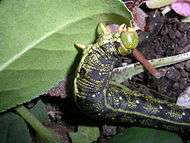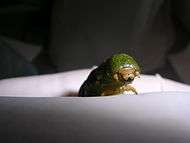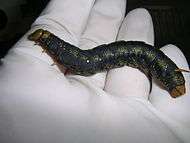Hyles lineata
| White-lined sphinx | |
|---|---|
.jpg) | |
| Hyles lineata feeding | |
 | |
| The caterpillar varies widely in coloration, from black with stripes to green with red spots. | |
| Not evaluated (IUCN 3.1) | |
| Scientific classification | |
| Kingdom: | Animalia |
| Phylum: | Arthropoda |
| Class: | Insecta |
| Order: | Lepidoptera |
| Family: | Sphingidae |
| Genus: | Hyles |
| Species: | H. lineata |
| Binomial name | |
| Hyles lineata (Fabricius, 1775)[1] | |
| Synonyms | |
| |
Hyles lineata, the white-lined sphinx or hummingbird moth, is a moth of the family Sphingidae. Its range extends from Central America, through the United States and into parts of Canada.
Description
The forewing is dark brown with a tan stripe which extends from the base to the apex. There are also white lines that cover the veins. The black hindwing has a broad pink median band. It has a wingspan of 2 to 3 inches.[2] The moth is sometimes referred to as a hummingbird moth because of its similarity to the hummingbird in appearance and flight characteristics.
Flight
The white-lined sphinx may be encountered from March to October.[2] This moth's rapid wing movement resembles a hummingbird in flight when it hovers over flowers while it feeds. They may also be seen darting in a back-and-forth pattern over nectar sources, or larval food sources.
Range
The moth's range is throughout the United States and extends north into southern and mid-western Canada and south into Mexico. It can also be found occasionally in the West Indies.[3] See also List of butterflies and moths of Arizona.
Life cycle
The larva is yellow and black or sometimes lime green and black. Many individuals have a subdorsal stripe. The head, prothoracic shield, and the anal plate are one color either green or orange with small black dots. The horn varies from either yellow or orange and sometimes has a black tip.[4] Larvae burrow into soil to go into pupal stage, where they remain for 2–3 weeks before they emerge as adults.
Host plants
The adult of this species is a key pollinator of the rare lemon lily (Lilium parryi) in California.[5]
The caterpillars of this species eat:
- Willow weed (Epilobium)
- Four o'clock (Mirabilis jalapa)
- Apple (Malus)
- Evening primrose (Oenothera)
- Elm (Ulmus)
- Grape (Vitis)
- Tomato (Lycopersicon)
- Purslane (Portulaca)
- Fuchsia
- Clarkia elegans
- Cuphea ignea
Gallery

.jpg) Adult, Los Alamos, New Mexico
Adult, Los Alamos, New Mexico- Adult, Montezuma County, Colorado
- In flight over showy evening primroses
 Larva and egg
Larva and egg Larva feeding
Larva feeding Larva – head close-up
Larva – head close-up Larva shortly before pupating
Larva shortly before pupating Mating
Mating
References
- ↑ "CATE Creating a Taxonomic eScience - Sphingidae". Cate-sphingidae.org. Retrieved 2011-10-25.
- 1 2 Charles V. Covell, Jr. (1984, 2005). Moths of Eastern North America. Virginia Museum of Natural History, Martinsville, VA. ISBN 1-884549-21-7
- ↑ "Butterflies and Moths of North America | collecting and sharing data about Lepidoptera". Butterfliesandmoths.org. Retrieved 2011-10-25.
- ↑ David L. Wagner (2005). Caterpillars of Eastern North America. Princeton University Press, Princeton, NJ. ISBN 0-691-12144-3
- ↑ "''Lilium parryi''". Center for Plant Conservation. Retrieved 2011-10-25.
External links
| Wikimedia Commons has media related to Hyles lineata. |
- White-lined sphinx Butterflies and Moths of North America